The Thompson Chain Reference Bible is one of the oldest study Bibles on the market. The first edition, and KJV, was printed in 1908. It’s considered a complete Bible reference library in one volume, but what’s interesting is it does this without having any commentary. Instead it has lists of topics and chain references throughout the Bible. With over 8000 topics and 100,000 chain references it’s easy to see why it’s been around for so long.
It’s available in several popular translations and each one has a few tweaks of their own. In this review I take a look at the NKJV edition.
Binding
The cover on this edition is black bonded leather and a vinyl liner. It’s fairly stiff and the material is thin. It’s Smyth sewn and lays open and flat on every page. I don’t know if this bonded leather is the same as my wife’s older Thompson or if it now has more fibers. If it’s the same as hers then I don’t expect this cover to hold up well. Regardless, I recommend spending the extra and getting the genuine leather or even better – rebinding this one with edge-lined cow hide, calf skin, or goatskin as the need arises.
The spine actually folds in the middle and the gutter raises up to make the pages lay flat. It’s more prominent when laying in your hands rather than on a table. I think the Thompson lays flatter than any Bible I’ve seen. It’s the size of a standard study Bible at 9.5 x 6.75 x 1.8.
Typography
There are four columns per page. The two centered columns are the Biblical text and the two outer columns are the chain references. At first it looks like it was designed by a team of 6 engineers. I would contend that it was actually 5 engineers and 1 artist.
The text is verse by verse with all poetry set in stanzas. Paragraphs are indicated with bold verse numbers. Letters that are written to individuals, such as found in Ezra, are set apart and labeled but unlike most NKJV’s they’re not indented.
The font is 8 point. It’s about a medium darkness and is easy to read. The red letter is light/medium red that continues through Revelation. The boldness is fairly consistent throughout. Words that someone is speaking is in quotations. I’d like to see this feature in the KJV edition.
The columns are a narrow 1.6” and has 30 characters across. There’s enough spacing between the words and letters for comfortable reading. Even with the narrow columns it never feels cramped. The poetic settings often have a single word on a line. Other than that the poetic settings look nice. The columns of text is the artistic side of the Thompson’s layout. The text is readable and clear of distractions, making this an easy Bible to read for long periods of time.
It includes both section headings and chapter summaries. Section headings include references to parallel passages. These are in italics to help them stand apart from the text. There are also some bold section headings in the margins of the New Testament. The first page of a book includes the author, topic number for the analysis, keyword, and key verse. Books start on a new page.
Chapters are indicated with the word Chapter and the number rather than using a number as a drop-cap. The first word of a verse is bold.
The header includes the page summary, book name, chapter number, and first or last verse on the page.
Paper
The paper is thin, but with just over 2400 pages it has to be. It’s white, doesn’t have a shiny glare (well, just slightly – but it’s not enough to annoy me), and is fairly opaque. It’s not so thin that I have trouble turning pages. Also it doesn’t crease easily while I’m turning pages. It’s good paper for marking and making notes.
References
This Bible has the Thompson chain reference system which has 100,000 marginal references and 8000 topical listings. It actually has more chains and topics than the KJV edition. The reference system shows the topic number (you can go to this number in the back for the complete list of verses under that topic), the topic name, and the next reference in that topic. It also includes parallel passages.
Rather than keying the references to the verses, the references are placed next to verses they correspond to. Sometimes there’s more than one subtopic under the main topic. When this is the case the number of the subtopic is given in parenthesis.
Here are some examples of references and their topics:
- Genesis 1:1
- PP Jn 1:3; Heb 1:10
- 1672 Family Bible Readings, Ge 3:1-6
- 884 Creator, 2:3
- 1550 Heavens (1), 1 Chr 16:26
- 1090 Earth, 8:22
- Matthew 17:20
- 1219 Unbelief (1), Lu 1:20
- 1204 Faith (4), 21:21
- 2183 Human Supplies, 18:20
- 2478 Mustard Seed, Mk 4:31
- 1562 Obstacles Removed
- 2880 Promises to Believers
- 3803 Spiritual Power
- Mark 11:23
- 3751 Assuredly
- PP Mt 21:21; Lu 17:6
- 1562 Obstacles Removed
- 1204 Faith (4)
- 1211 Faith Honored
- John 1:1
- 709 Christ Eternal, 8:58
- 700 Christ the Word, 1:14
- 3632 Christ’s Names
- 702 Christ Divine (2), Ro 1:4
- 1 John 1:1
- PP Lu 24:39
- 2030 Experimental Knowledge (2)
- 3855a Witness (2)
- 700 Christ the Word, Rev 19:13
- 709 Christ Eternal
Not every topic is found in the margin and sometimes the wording is slightly different between the margin and the index. This is always pointed out in the index. The margins also indicate the start and end of a chain. Some topics don’t give a reference. You can find these references in the index.
I’d like to see the end of a chain give the first verse so you can start at the beginning in case you started somewhere else in the chain (which is often the case for me when something caught my attention).
The chain reference system is what makes the Thompson so useful, but it also looks like a Bible for engineers rather than a Bible for artists. If you’re the analytical type (like me) you’ll feel at home. I know several people who have steered clear of the Thompson because of the daunting look of the numbering system in the margins. It’s not as confusing as it looks and is well worth the little effort it takes to learn to use it. It’s actually intuitive to use and easy to ignore.
Footnotes
The footnotes are the standard translators’ notes that are part of the NKJV translation. They appear in the footer. They are keyed to the text with numbers. I like the NKJV footnotes a lot. In my personal opinion the footnotes from the NKJV add to its strength as a translation. I’d like to see these same notes in the KJV edition.
They include textual variants between manuscripts (United Bible Society, Nestle-Aland, Majority, Bomberg, Syriac, Septuagint, Targum, Vulgate, Dead Sea Scrolls, etc.). They include Hebrew, Aramaic, and Greek words, literal renderings, and alternate renderings. They show where something took place or was quoted from. They include alternate spellings of names and show where a name was spelled a different way.
Comprehensive Bible Helps
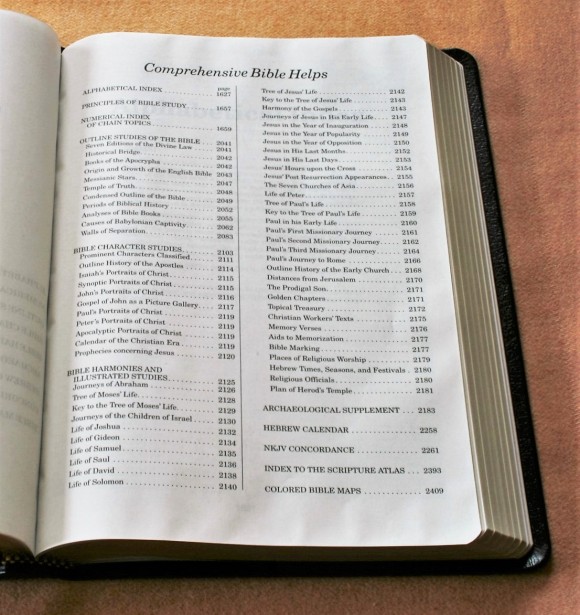
There are 75 features in the back under 9 different compartments for Bible study. That explains why this section is around 800 pages.
Alphabetical Index
This is a 28-page index that has every topical found in the back section of the Thompson. It has 4 columns per page. This index is essential in getting the most out of the numeric index. This index makes it much easier to find what you’re looking for.
Principles of Bible Study
This is a quick overview of Bible study methods. It gives information about the spiritual attitude, conscious need, first-hand knowledge, etc. It discusses developing a systematic method and covers topical study, biographical study, book study, chapter and passage study, and verse study.
Numerical Index of Chain Topics
This is the primary topical section of the Thompson Bible. It’s 380 pages and includes 4218 topics. Each topic is given a number. These numbers correspond to the numbers given in the margins of the Bible section. For example, if you’re looking at the topic of Aaron, you’ll see that the margin gives the number 1. You turn to topic number 1 in this section and you find the references for Aaron. Many verses just give the references while many others print the complete verse. Almost every topic gives the numbers for other related topics. It can be a little difficult to use because not everything is categorized as primary topics. It’s best to use the alphabetical index for searching.
I like to turn to this section and just start reading. It’s a great resource for devotions. It’s especially helpful for topical study and sermon prep. It even includes all the names and titles of Christ. When you consider that the numerical system is the same for the KJV, NKJV, NASB, and NIV editions, and that the Thompson system has been around for over 100 years, the number of sermons, devotions, books, and studies that have been developed from these pages probably reach seven figures. All it takes is a few minutes of using it to see why.
Outline Studies of the Bible
This section contains lots of outlines and charts. They give a brief overview of Biblical history, periods of history between the testaments, and a brief survey of Biblical manuscripts and translations up to the NLT in 1996. I’d like to see it updated to include the ESV (there’s enough room on the page for it).
The sections include:
- Seven Editions of the Divine Law
- The Historical Bridge
- Origin and Growth of the English Bible
- The Messianic Stars
- Temple of Truth
- Condensed Outlines of the Bible
- Periods of Biblical History
- Analyses of Bible Books
Bible Character Studies
These are biographical sketches and outlines of the prominent characters in the Bible. There are lists of Scripture, charts, drawings, outlines, etc. It has several sections.
The First section includes:
- Noah
- Abraham
- Jacob
- Joseph
- Joshua
- Gideon
- Samuel
- David
- Solomon
- Elijah
- Elisha
- Daniel
Next is prominent characters classified with the meaning of their names, outline history to the apostles, Isaiah’s portraits of Christ, synoptic portraits of Christ, prophecies of Christ, their fulfilments, and more.
Bible Harmonies and Illustrated Studies
This section has 32 entries and includes illustrated maps, life trees, charts, and outlines. It covers biographical harmonies of Moses, Jesus, and Paul. They cover important events in Biblical history. There’s even a Harmony of the Gospels.
It also includes a Topical Treasury. This is a list for Christian workers and includes Scripture lists for prayer and devotional meetings, youth meetings, men’s meetings, women’s and children’s meetings, evangelistic meetings, missionary meetings, temperance meetings, special days, the Christian workers text, memory verses, aids to memorization, Bible marking, etc.
Archaeological Supplement
This section was written by G. Frederick Owen and revised by Dennis W. Cheek with the assistance of David Livingstone and Edwin M Yamauchi. It includes a chronological chart showing historical periods. It covers many archaeological finds including the Rosetta Stone, many places, artifacts, tablets, the Moabite Stone, Petra, Dead Sea Scrolls, and lots more. There are 131 entries, lots of black and white photos, and a list of resources for further study.
Hebrew Calendar
This shows the English months, Jewish months, festivals, season, weather, and agricultural conditions of each month of the Jewish calendar. This is helpful for understanding the setting any time the Bible talks about a specific month.
Concordance
I’ve always said that Thompson has one of the best concordances in a Bible and this one is no different. It’s 129 pages with 3 columns per page. Here are some example entries and the number of references given:
- Christ – 33
- Christian – 2
- Christians – 1
- Christs – 1
- Faith – 56
- Faithful – 26
- Faithfulness – 9
- Faithless – 2
- God – 70
- Goddess – 2
- Godhead – 2
- Godliness – 6
- Godly – 6
- Gods – 7
- Praise – 38
- Praised – 6
- Praises – 5
- Praiseworthy – 1
- Praising – 3
- Pray – 22
- Prayed – 3
- Prayer – 21
- Prayers – 8
Index to the Scripture Atlas
There is an extensive index. It’s divided into 6 divisions:
- Archaeological Sites
- Biblical Names
- Cultural Features
- Points of Interest
- Land Features
- Water Features
The index is 12 pages. I’m very glad to see the index to maps included. This should be standard in Bibles in my opinion because they make finding locations much easier.
Bible Maps
There are 14 full-color maps on thick non-glossy paper. Maps include:
- Archaeological Sites in Palestine
- Archaeological Sites in the Bible Lands
- The Ancient World of the Patriarchs
- The Twelve Tribes of Canaan
- The Kingdoms of David and Solomon
- The Davidic Kingdom – Israel and Judah
- The Assyrian Empire
- Palestine in the Time of Our Savior
- The City of Jerusalem in Old Testament Times
- The City of Jerusalem in New Testament Times
- Paul’s First and Second Missionary Journeys
- Paul’s Third and Fourth Missionary Journeys
- The Growth of the Christian Community, First and Second Centuries
- The Holy Land Today
They include boundaries, routes, and topography. The labels are bold and easy to see.
Thoughts on Using It
Any one of the tools for topical study would be helpful for devotions, personal study, and sermon prep. All of the tools combined make the Thompson a resource that’s hard to beat.
My favorite thing about the TCR is the lack of commentary. A good study Bible will give you the tools to do your own study and come to your own conclusions – allowing Scripture to interpret Scripture. That’s what the TCR does, and it does it better and more completely than any study Bible I know. I love the fact that it’s topical. I do a lot of topical study and Thompson is always on my list of resources.
The text itself is clean and free of distractions. This is something I’ve always appreciated from Thompson. This makes it easy to read. The font looks darker than the KJV to my eye. Also, the keywords in the index and concordance are bolder.
I like the idea of giving the topic names in the margins. A lot of times in wide margin Bibles I like to make a note about a topic, just as a reminder so I can find it quick. The Thompson already has it. Sometimes I like to color-code according to topic. With this system I color the topic name. This is handy if you want to highlight but still keep your text clean.
If I Could Change One Thing
I’d like to see the Thompson available in a premium edition complete with high quality cover, paper, ribbons, and art-gilt edges. I know it would cost $200, but the Thompson Chain Reference is so well-loved that it’s worth the premium treatment. I dream of a TCR produced by Jongbloed. I want that.
Conclusion
The NKJV edition of the Thompson Chain Reference Bible has a lot of the features that I’ve wanted to see the KJV have. Even though it’s verse by verse it still retains the poetic setting. This is enough to allow the poetic text to stand apart from prose and give your eyes something else to see. The section headings within the text are helpful when searching and they break up the text into sections. They can also be ignored if you want.
The real advantage is the topical chain system. I love having the topic names in the margins and the index in the back is an excellent tool for my kind of topical study – letting Scripture interpret Scripture. The NKJV footnotes are very helpful for reading and study. This is an excellent resource for personal study, devotions, and sermon prep. I personally believe everyone should have a Thompson Chain Reference Bible and the NKJV edition is a great choice.
You can see other cover choices and translations at their website: kirkbride.com
Kirkbride provided this Bible free for review. I was not required to give a positive review – only an honest review. My opinions are my own.

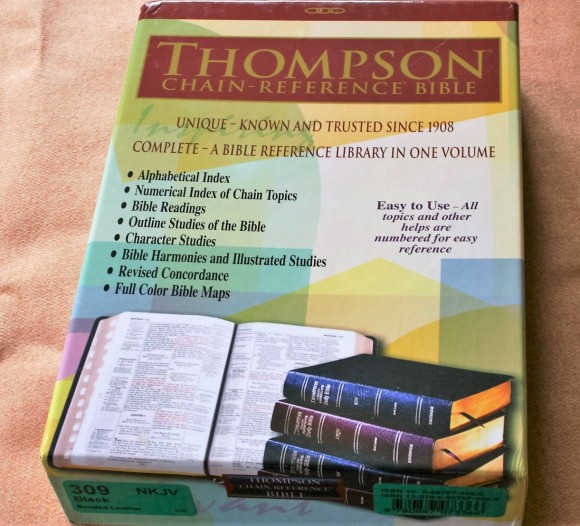
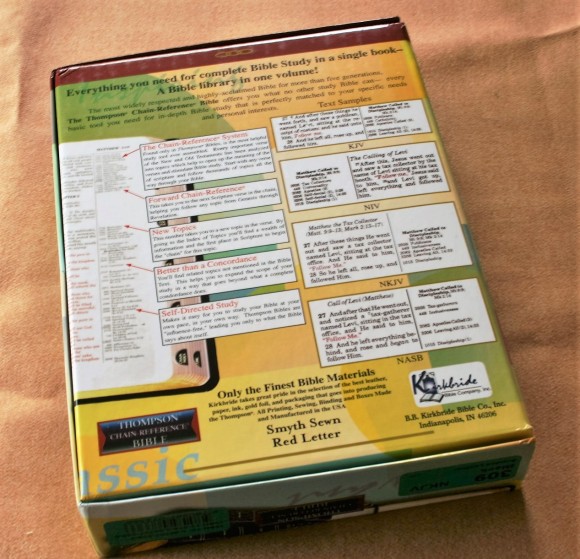
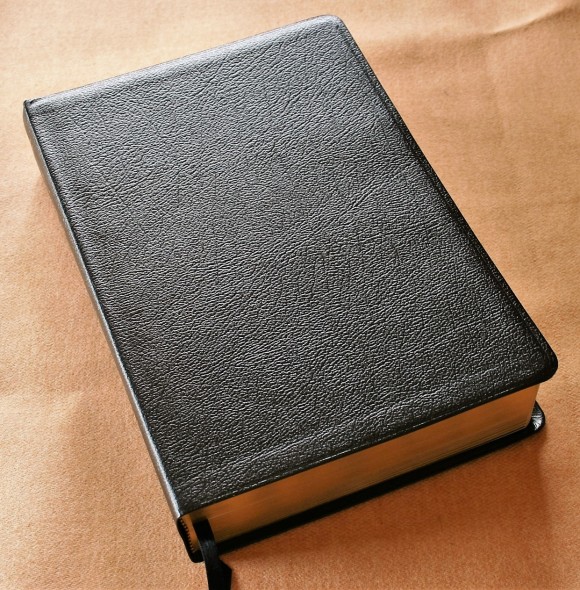
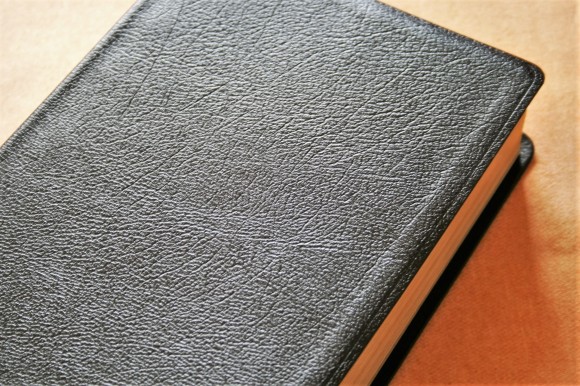
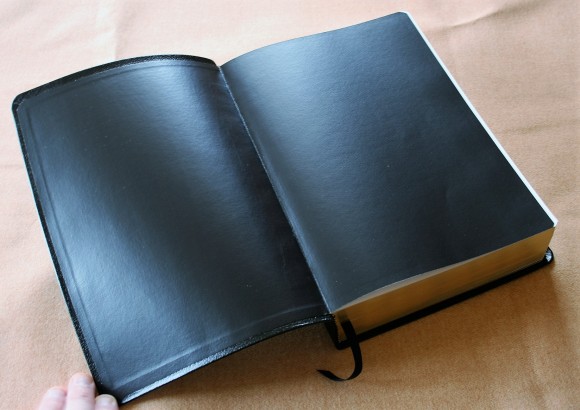
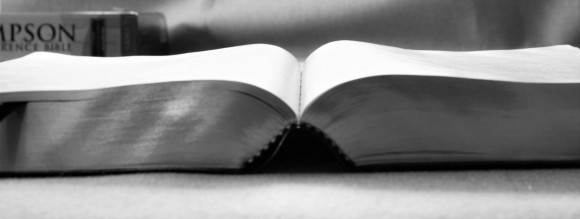

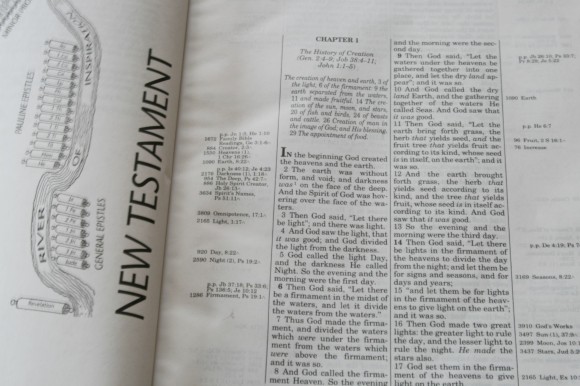
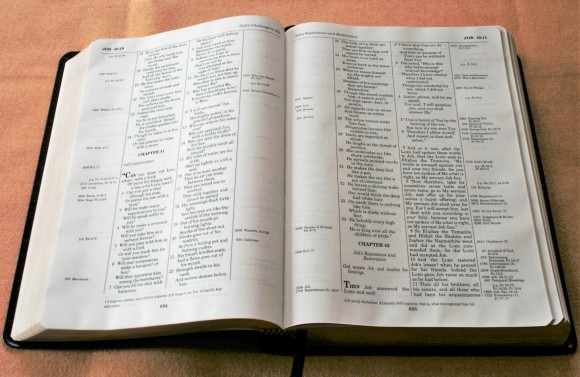
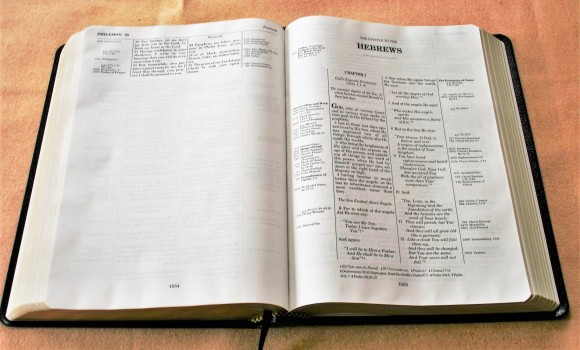
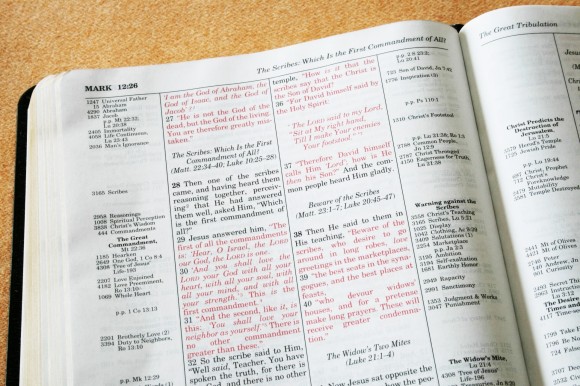

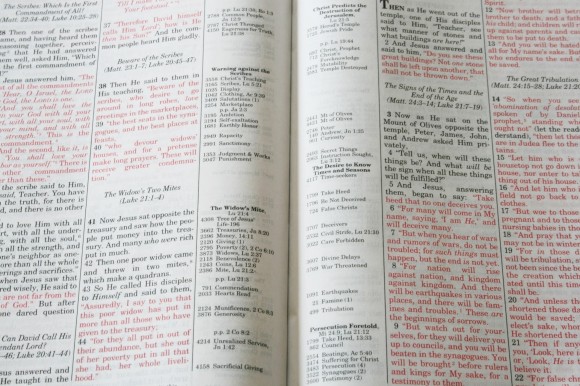
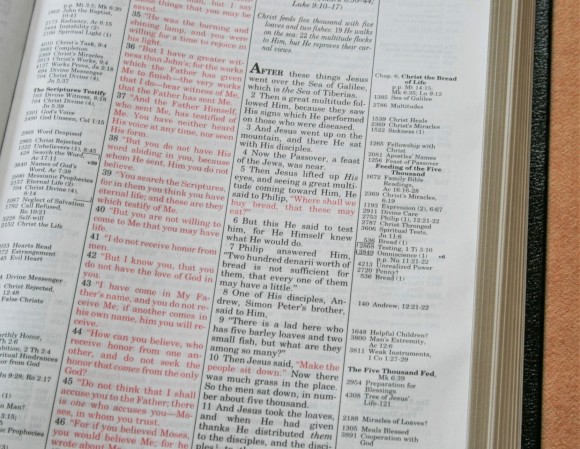
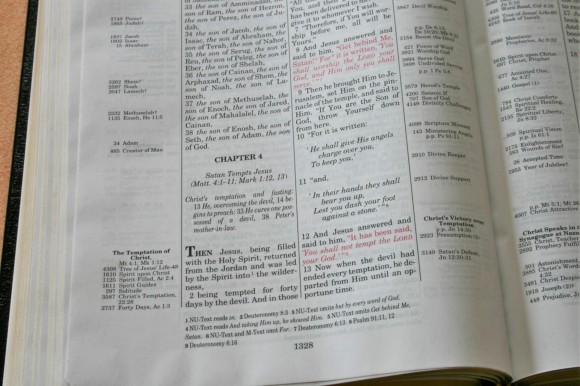
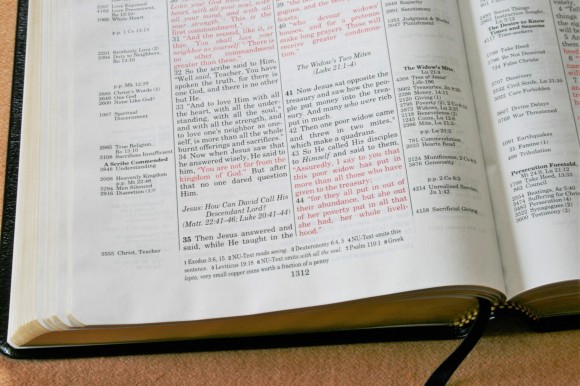
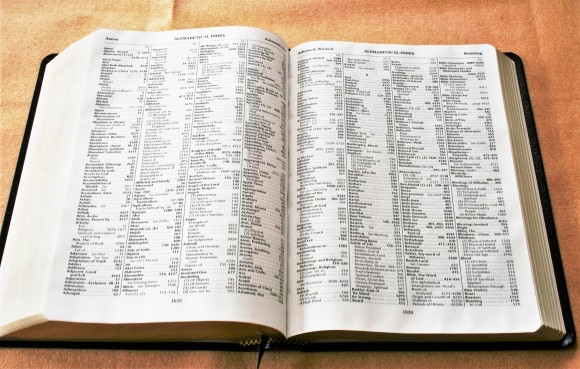
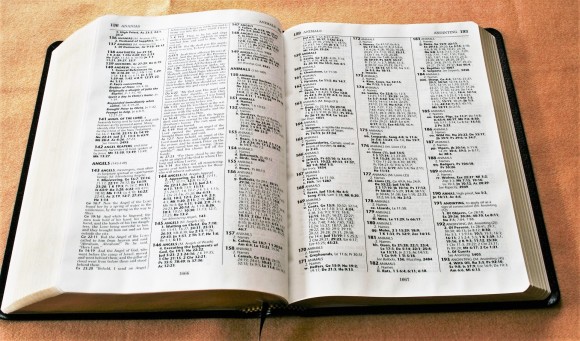
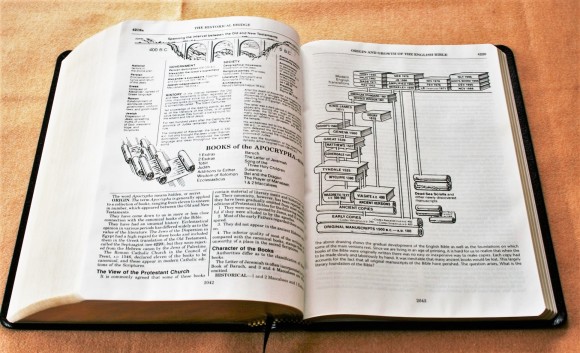
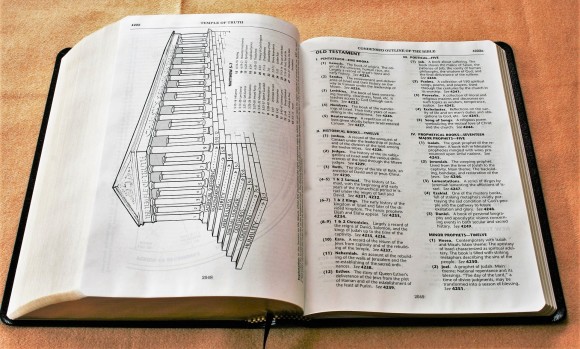
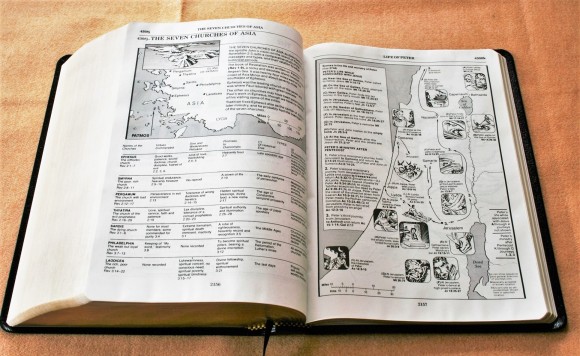
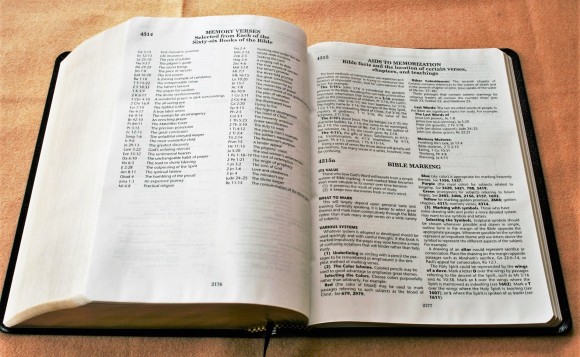
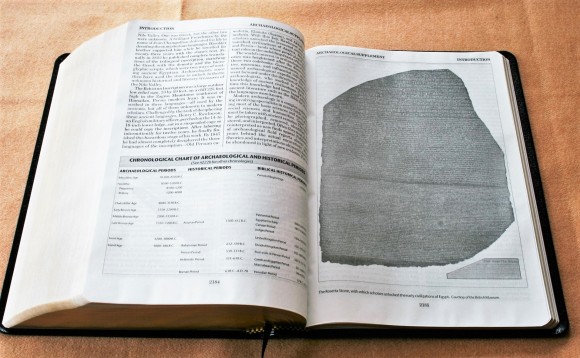
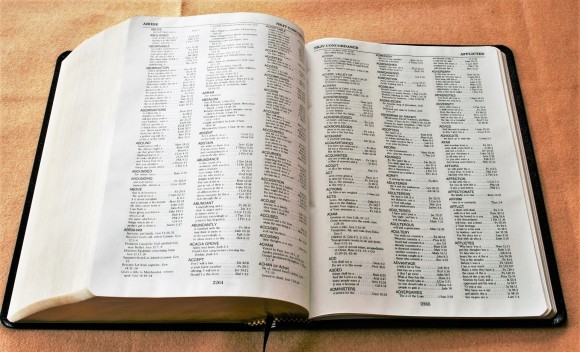
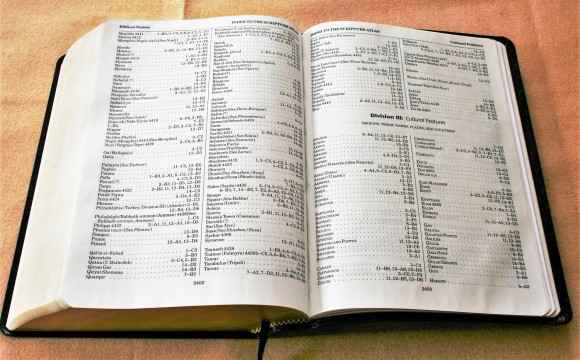
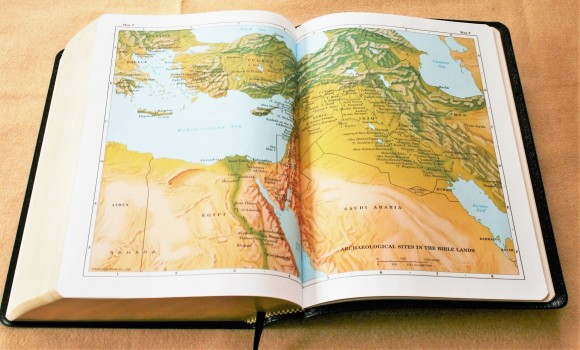
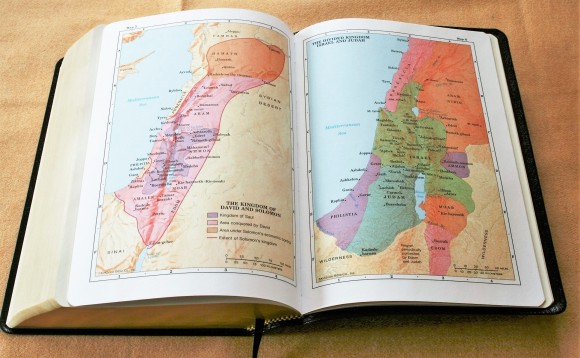




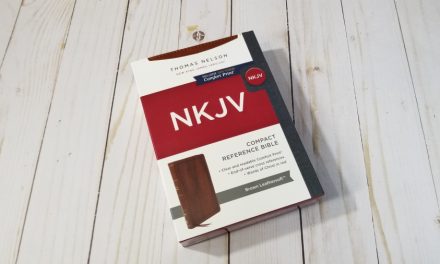





I WOULD LIKE TO RECEIVE A BIBLE CATALOG BY MAIL.
Hi Felix. You can contact them at their website: http://kirkbride.com/
Randy did you know that the Thompson Abridged Reference Bible is printed and bound by Jongbloed?
Wow! I did not know that! Thanks for the info. Now I know what I’m buying next!
Hi Randy,
Great review as always. I love the Thompson and own a large print KJV edition in Capri leather which unbelievably I picked up brand new on Amazon for £25, which is roughly equivalent to $38. I use it all the time and find it great for study. I do like the look of the NKJV though. The text does look cleaner and there appears to be more space between the lines of text. I am in agreement with you on that I too wish that they would give you the first reference of the chain so you don’t have to keep going to the back of the Bible.
With this in mind, have you seen the New Thompson study bible? This is not published by Kirkbride but is published with their permission by a company called La Buona Novella. It only comes in KJV and it is a lot smaller than the Kirkbride ones. They are probably around Pew bible size, and the ones I have seen are bonded leather or hardback. I own the black bonded leather version with a zipper, (I have also owned the hardback version and that too is great) The chains inside are somewhat simplified but most of the information is there that is in the standard Thompson. The difference is that this does give you an option of going forward or backward through the chains which is great. Most interesting though is that the book blocks of this are printed and bound by Jongbloed, this means the overall quality, i.e. font, paper, layout etc. is very good.
Frustratingly there is little about this Bible on the internet and whilst I have seen them in a few stores here in Scotland I have not come across them anywhere else. It is a great bible and whilst I probably prefer the Kirkbride for major study, it is great to be able to sit and read the New Thompson with one hand. If you want to see what it looks like, let me know and I will send you some pictures.
Thanks
Rob
Hi Rob. That sounds amazing. Is it the same as the Thompson Abridged Reference Bible? I would love to see photos. Thanks!
Hi, I purchased a NKJV in 2011. I love reading and using all of the helps that Thompson offer. But, I’m not thrilled how the outer spine turns into the bible instead off folding out. I understand that I have had this bible for awhile and I’m not expecting anything from Thompson. I guess it’s always bothered me and I want to replace this bible for my daily use. This bible is genuine Leather and I guess I never expected anything like this to happen! What would you suggest. I will likely be purchasing a replacement in the next couple of months except this time I will the genuine leather with book tabs. I think it would help. I have purchased two Thompson Bible and won a Thompson NIV. Can you help me make up my mind, thank you, Ivan Doherty
Hi Ivan. Have you considered having your Thompson rebound? I’ve seen a few rebound Thompson’s on Facebook and they look amazing. I plan to have mine rebound in cow hide or goatskin when I wear it out.
Great review. My only wish, is that they would remove the “textual variants” and keep the other footnotes. I don’t like being told what the corrupt, minority critical texts changed or omitted. Here’s a good quote from Origen on the Alexandrian manuscripts from around 200 AD:
“…the differences among the manuscripts have become great, either through the negligence of some copyists or through the perverse audacity of others; they either neglect to check over what they have transcribed, or, in the process of checking, they lengthen or shorten, as they please.”
There have been 2 really nice TCRBs. Nelson published one in their Signature series. It was a beautiful matte black calfskin. Bible Design Blog did mention this at some point. For the hundredth anniversary of the TCRB; Kirkbride released a numbered KJV in a lovely goatskin. Both are great editions.
Randy,
Many years ago, Nelson signature series included most if not all their study bibles in the premium series. And , this included the NKJV Thompson Chain study bible. I picked one up on sale for under 70.00. The paper is thinner than the Kirkbride Thompson and the print does not appear as bold , yet it is an amazing bound bible. Blessings.
Hi Prentiss,
I’ve always wondered about the Nelson Signature Thompson. It sounds interesting. What’s the cover like?
Randy,
The cover is in their signature series black calfskin. It’s edges are lined yet not sewn as a lcbp published bible. This bible is the size of a esv study bible in size. Thank you.
Hello, great review. Does the spine have a shortened life span due to it bending in the middle? I noticed that as soon as I got mine. I just figured it was the way they made these bibles. Thank you.
Hi Kevin. Thanks! It does look worrisome, but I’ve never had the spine to be the fail-point in a Thompson (with normal use). Mine have always come apart where the text-block attaches to the cover, which is typical of paste-down liners for large Bibles. As long as it isn’t folded backward I think the spine will be okay.
I am in South Africa and I am having difficulty in locating New King James Study Bible in Leather with or without a zipper.I need to get one urgently????
is the red letter different in the esv, kjv, nkjv and nasb? the red letter in my kjv thompson is horrible. wanted to know if they fixed the red in the other translations.
The red is the same for all of the translations.
“My favorite thing about the TCR is the lack of commentary. A good study Bible will give you the tools to do your own study and come to your own conclusions – allowing Scripture to interpret Scripture. That’s what the TCR does, and it does it better and more completely than any study Bible I know. I love the fact that it’s topical. I do a lot of topical study and Thompson is always on my list of resources.”
Randy, thank you for your helpful review. I do appreciate this very much, and it was on the strength of your review that I purchased a copy of this Bible.
I do want to (respectfully!) note that, while I agree with the power of doing one’s own study and mining from God’s word firsthand; there’s a very real sense that all of the guided topical research, analyses, harmonies and studies are definitely interpretive and so are a sort of commentary of their own. A guided study, using some of those tools, isn’t far removed from using a commentary-laden text.
Thanks again, and thanks for letting me comment!
Thanks John. I agree. References can be used to lead your train of thought, and they can take Scripture out of context. This is the danger of topical study.
Where can i get this bible
Christianbook has one model in stock and they’re getting another one soon: https://www.christianbook.com/Christian/Books/easy_find?Ntt=nkjv+thompson+chain+reference+bibles&N=0&Ntk=keywords&action=Search&Ne=0&event=ESRCQ&nav_search=1&cms=1
do you have the nkjv in large print?
Hi Charles. I’ve never reviewed that one. Sorry.
how can I get this in calfskin leather?
thanks
joe
Hi Joe. Your best option at the moment is to have one rebound. Kirkbride has sold the TCR to Zondervan. They will be producing it in different covers (and possibly the Premier Collection), but I’m not sure if calfskin will be an option.